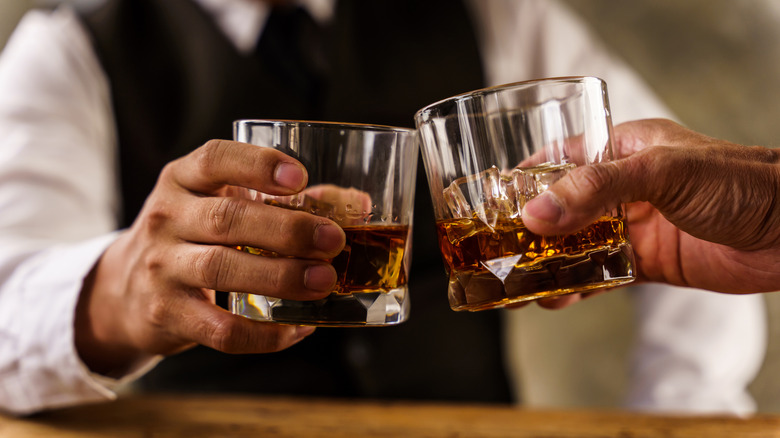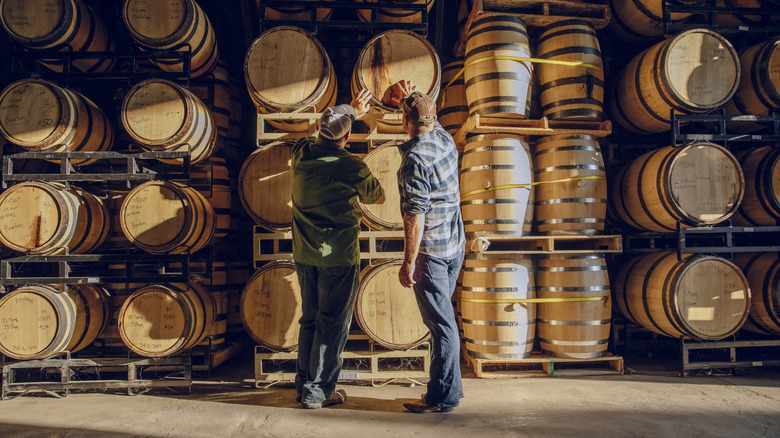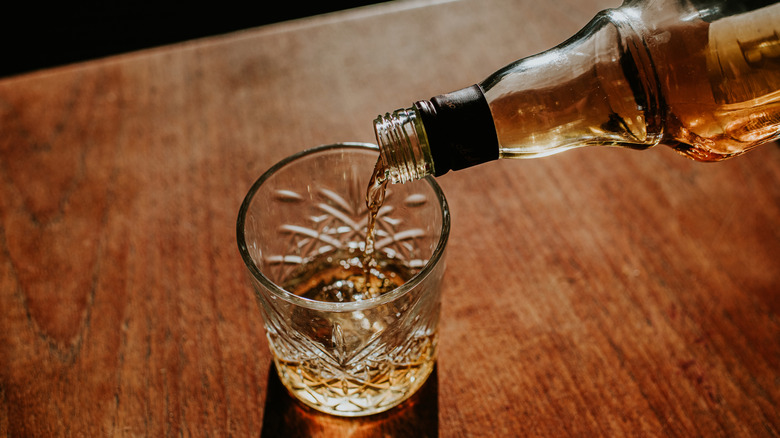The Big Differences Between American Vs Scottish Whiskey
For pretty much everyone who knows and enjoys their spirits, whiskey is a beloved drink that pairs perfectly well with celebrations, quiet evenings, and good conversations. In fact, people have been sipping on this amber liquid for centuries — with Scottish whisky dating back to at least the 15th century, when it was known as "water of life" (or "Uisge Beath" in Scottish Gaelic) and was originally used for medicinal purposes before becoming popular with the general public.
That said, not all whiskey is created equal. In fact, most aren't even made with the same ingredients. And while many casual drinkers might not notice the differences at first sip, there's actually a major divide between two well-known traditions and regions that represent very different approaches to producing this iconic spirit: American whiskey and Scottish whisky.
For starters, and as you might have already seen, the most basic difference between the two styles starts with the spelling of the word itself. While American producers use "whiskey" (with an "e"), Scottish distillers drop the "e" and simply call it "whisky." A small variation that, as a starting point, leads to even bigger differences in everything from ingredients to production methods, aging requirements, and even flavor profiles.
There's a difference in ingredients and production methods
Beyond the name, the American and Scottish styles also differ in terms of ingredients and production techniques. Specifically, American whiskey starts with a mix of grains that varies depending on the style. So, while a drink like bourbon needs at least 51% corn, rye whiskey requires at least 51% rye grain. As for cooking methods, American distillers prefer to cook these grains at high temperatures, often boiling them, and generally keep all the grains in the mixture during the distillation process. For true whiskey lovers, embarking on a tour of the best distilleries in the U.S. isn't just a great way to appreciate the craft, but it's also the perfect way to experience the country's bustling spirit industry.
On the other hand, Scotch, a designation that can only be given to whisky that's actually produced in Scotland, begins with malted barley — aka, barley that's been soaked in water, allowed to start sprouting, and then dried. From there, Scottish producers mash this barley with warm water and strain it before moving to distillation — a major departure from the typical American method, where the grains stay in the mix. A highlight of any trip to Scotland, visiting a local whisky distillery to see the process firsthand will give you an insight into centuries-old traditions.
Once distilled, the aging process is different too. While American straight whiskey has different aging requirements based on the type, charred oak barrels, Scotch needs a minimum three-year aging period and typically uses bourbon barrels imported from the U.S. Additionally, in the American climate, whiskey tends to lose water during aging, which ultimately increases its alcohol content. However, in Scotland's cooler, damper climate, Scotch actually gains water and loses alcohol strength as it ages.
The flavor profiles also tend to vary
Flavor also plays a huge role in how American whiskey and Scotch differ from one another. Specifically, most styles of whiskeys typically have bolder, more pronounced flavors. While bourbon is often known for its sweet notes of caramel, vanilla, and oak with a rich mouthfeel, other variations like rye whiskeys tend to have spicier profiles that taste almost like pepper. Color-wise, the use of new charred barrels gives American whiskeys their distinctive amber color and adds significant vanilla and caramel characteristics that define the style.
In contrast, Scotch tends to have a much more diverse flavor profile that's often a reflection of the region it was produced in. For example, Speyside Scotches — including popular brands like Glenfiddich and Macallan — typically have much sweeter, and much more accessible profiles with fruit, caramel, and floral notes. Meanwhile, Islay Scotches from distilleries like Laphroaig and Ardbeg are known for their strong smoky character — a result of drying malted barley over burning peat.
Oh, and while it might seem tempting to order a glass and kick it back instantly like you might be used to back home, make sure that you never shoot whisky in Scotland unless you want to immediately out yourself as a tourist. Instead, take the time to savor it by adding a few drops of water to open up the aroma.


